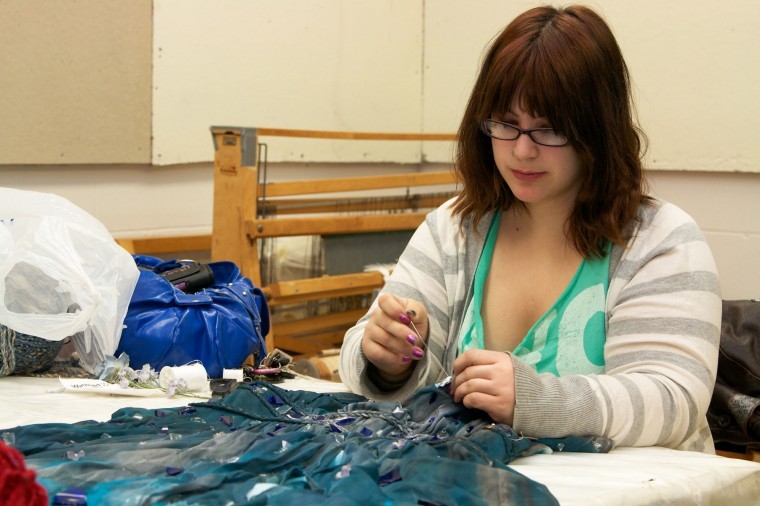Student puts heart into art
Liz Howell, senior fiber art major, sews glass onto a silk dress that she hopes to finish for her exhibition Friday.
February 9, 2012
For a few months, Liz Howell felt dizzy and fatigued, but she wasn’t quite sure what was wrong. That changed when the fiber art senior found out her resting heart rate was 30 bpm. It should’ve been between 50 to 90 bpm.
Howell said the cardiologist reassured her: “I don’t put pacemakers in 20-year-olds. You’ll be fine.”
But a year ago when Howell fainted while taking a stress test, the cardiologist changed his mind. He told Howell she needed a pacemaker.
Howell said getting the pacemaker turned out to be the best thing that ever happened to her. Not only did the experience influence her art, but it also changed her life. An art reception exhibiting Howell’s work will be held from 7 to 9 p.m. on Friday at the DeKalb Area Women’s Center (DAWC).
“My life is so much better”
After getting the pacemaker, Howell said she broke up with an “awful boyfriend,” lost 65 pounds and made the dean’s list for the first time.
“Everything just turned out to be amazing and I just channeled all of my anger and all of my frustration into my art and you can see it,” she said. “That’s why I feel like I had to do this series based on your soul and your life force, like I somehow pulled it out of me to make all these changes in one year. That’s got to come from somewhere.”
When she was weighed at the hospital, Howell said “it was a big wake-up call.” Since then Howell has started working out more.
“Being in the hospital completely alone, I was like, ‘I could die,'” Howell said. “That wasn’t a good experience and I knew I had to change that. I feel so much better. My life is so much better.”
A lot of her art is about hearts
Howell can’t remember when she first started doing art, but she said her work has always been heavily influenced by a rare genetic condition she has called Holt-Oram syndrome.
According to the National Institutes of Health’s Office of Rare Diseases, less than 200,000 people in the U.S. have this condition.
Howell has a hole in her heart and two leaking heart valves. She said the pacemaker makes sure her heart rate never drops below 60 bpm. It also changes her heart rate to accommodate her movement, she said.
Because she has this condition, Howell is most likely infertile and has deformed bones.
Despite her medical challenges, Howell has always found solace in her artwork, which mainly consists of hearts, or is inspired by the challenges she has faced.
“It’s just an amazing force that I can manifest my emotions into and I have something to show for it when I’m done,” she said. “All of the art surrounding me in my apartment is the most amazing thing because anytime I feel terrible or if I just want to crawl in a hole and die, I just look around at all of my art and I’m like, ‘I got through that.'”
“The best experience of my life”
At the DAWC art reception on Friday, Howell will present her exhibit called “Soulular Flare.” Similar to how a solar flare has a sudden brightening of the sun, Howell said she had a sudden realization that she has a soul. The exhibit will also feature a series Howell made that involves three cocoons and a mannequin called, “Rebirth.” Howell said it symbolizes how she reinvented her old self.
Anna Marie Coveny, DAWC art gallery director said she considers all art, including Howell’s, to be a form of self-portrait.
“I think she’s very good at combining her personal life with her artwork,” Coveny said. “The experiences she’s had do show through in the design.”
Howell said for the “Rebirth” series, she cut out a mannequin’s chest cavity and placed a mirror where the heart would be.
“The mannequin is supposed to represent me coming from that period of transition and becoming myself,” she said. “Although I had to have surgery on my chest, that’s what it took to change my life…Pulling out the chest cavity kind of, for me, represented taking everything that was bad out of my life and redefining it. I’m truly discovering who I was, which is why the mirror is in there. It’s like I had to look at myself once through clear eyes. I couldn’t look at myself in the mirror and say, You’re disgusting. You’re ugly. That’s what I used to do. I can’t do that anymore…I feel like gutting that chest cavity was the best experience of my life.”







